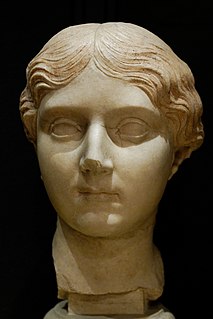Year 54 BC was a year of the pre-Julian Roman calendar. At the time, it was known as the Year of the Consulship of Appius and Ahenobarbus. The denomination 54 BC for this year has been used since the early medieval period, when the Anno Domini calendar era became the prevalent method in Europe for naming years.
Year 74 BC was a year of the pre-Julian Roman calendar. At the time it was known as the Year of the Consulship of Lucullus and Cotta. The denomination 74 BC for this year has been used since the early medieval period, when the Anno Domini calendar era became the prevalent method in Europe for naming years.

Year 17 BCE was either a common year starting on Sunday or Monday or a leap year starting on Saturday, Sunday or Monday of the Julian calendar and a leap year starting on Friday of the Proleptic Julian calendar. At the time, it was known as the Year of the Consulship of Furnius and Silanus. The denomination 17 BC for this year has been used since the early medieval period, when the Anno Domini calendar era became the prevalent method in Europe for naming years.

Gnaeus Domitius Ahenobarbus was a general and politician of ancient Rome in the 1st century BC.

Antonia the Elder was a niece of the first Roman emperor Augustus, being the eldest daughter of Octavia the Younger and her second husband the Triumvir Mark Antony. She married Lucius Domitius Ahenobarbus and became the maternal grandmother of empress Messalina as well as paternal grandmother of the emperor Nero.

Gnaeus Domitius Ahenobarbus was a member of the imperial Julio-Claudian dynasty of Ancient Rome. Domitius was the son of Antonia Major. He married Agrippina the Younger and became the father of the Emperor Nero.

Lucius Domitius Ahenobarbus was the son of consul Gnaeus Domitius Ahenobarbus and Aemilia Lepida. His mother was a paternal relative of the triumvir Marcus Aemilius Lepidus. His paternal grandmother was Porcia. Ahenobarbus married Antonia Major and through his son with her he became the grandfather of emperor Nero.

Gnaeus Domitius Ahenobarbus was a general and senator who served as consul in 122 BC. He led a campaign to conquer southern Gaul against the Allobroges together with his successor Quintus Fabius Maximus Allobrogicus. Domitius was active in the early development of southern Roman Gaul, establishing the first Roman colony at Colonia Narbon Martius, and sponsored projects such as the Via Domitia connecting Italy to Spain through southern Gaul. He was probably also the sponsor of the Altar of Domitius Ahenobarbus in the Temple of Neptune in Rome. Ahenobarbus was censor in 115 BC and became pontifex at an unknown date before dying circa 104 BC.
Gnaeus Domitius Ahenobarbus was tribune of the people in 104 BC. He was the son of Gnaeus Domitius Ahenobarbus, and brother of Lucius Domitius Ahenobarbus. The college of pontiffs elected him Pontifex Maximus in 103.
Lucius Domitius Ahenobarbus, consul in 54 BC, was an enemy of Julius Caesar and a strong supporter of the aristocratic (Optimates) party in the late Roman Republic.
Lucius Domitius Ahenobarbus may refer to:
This article concerns the period 99 BC – 90 BC.
Lucius Domitius Ahenobarbus was a politician in ancient Rome during the late 2nd and early 1st century BC. He served as praetor in Sicily, probably in 96 BC, shortly after the Second Servile War, when slaves had been forbidden to carry arms. He ordered a slave to be crucified for killing a wild boar with a hunting spear. He was consul in 94 BC. In the civil war between Gaius Marius and Sulla, he took the side of the latter, and was murdered at Rome by the praetor Damasippus on the orders of Gaius Marius the Younger.
Gnaeus Domitius Ahenobarbus was a politician of ancient Rome in the 1st century BC. The son of Gnaeus Domitius Ahenobarbus, and brother of Lucius Domitius Ahenobarbus; his name in latin means "brazen beard", from ahenus - "brazen, bronze-colored", and barbus, itself from barba, the latin word for "beard". He married Cornelia, daughter of Lucius Cornelius Cinna, who was consul in 87 BC.

Bithynia and Pontus was the name of a province of the Roman Empire on the Black Sea coast of Anatolia. It was formed during the late Roman Republic by the amalgamation of the former kingdoms of Bithynia and Pontus. The amalgamation was part of a wider conquest of Anatolia and its reduction to Roman provinces.

Gaius Coelius Caldus was a consul of the Roman Republic in 94 BC alongside his colleague Lucius Domitius Ahenobarbus.
The gens Domitia was a plebeian family at ancient Rome. The first of the gens to achieve prominence was Gnaeus Domitius Calvinus, consul in 332 BC. His son, Gnaeus Domitius Calvinus Maximus, was consul in 283, and the first plebeian censor. The family produced several distinguished generals, and towards the end of the Republic, the Domitii were looked upon as one of the most illustrious gentes.

The gens Coelia, occasionally written Coilia, was a plebeian family at ancient Rome. The Coelii are frequently confounded with the Caelii, with some individuals called Caelius in manuscripts, while they appear as Coelius or Coilius on coins. The first of this gens who obtained the consulship was Gaius Coelius Caldus in 94 BC.







